Analyzing Stakeholder Prioritization in Management Decision Making
VerifiedAdded on 2023/03/29
|12
|2630
|429
Report
AI Summary
This report critically examines the prioritization of stakeholders in management decision-making, emphasizing the importance of stakeholder engagement for long-term organizational success. It identifies primary and secondary stakeholders, detailing their responsibilities such as decision-making, direct management, and investor roles. The report highlights the stakeholder theory, advocating for decisions that consider stakeholder welfare, and discusses tools like stakeholder group analysis for effective prioritization. It also underscores that prioritizing stakeholders is essential for gathering information, clarifying relationships, and aligning decisions with stakeholder interests, ultimately contributing to the sustainability and ethical conduct of the firm. Desklib provides access to similar solved assignments and resources for students.
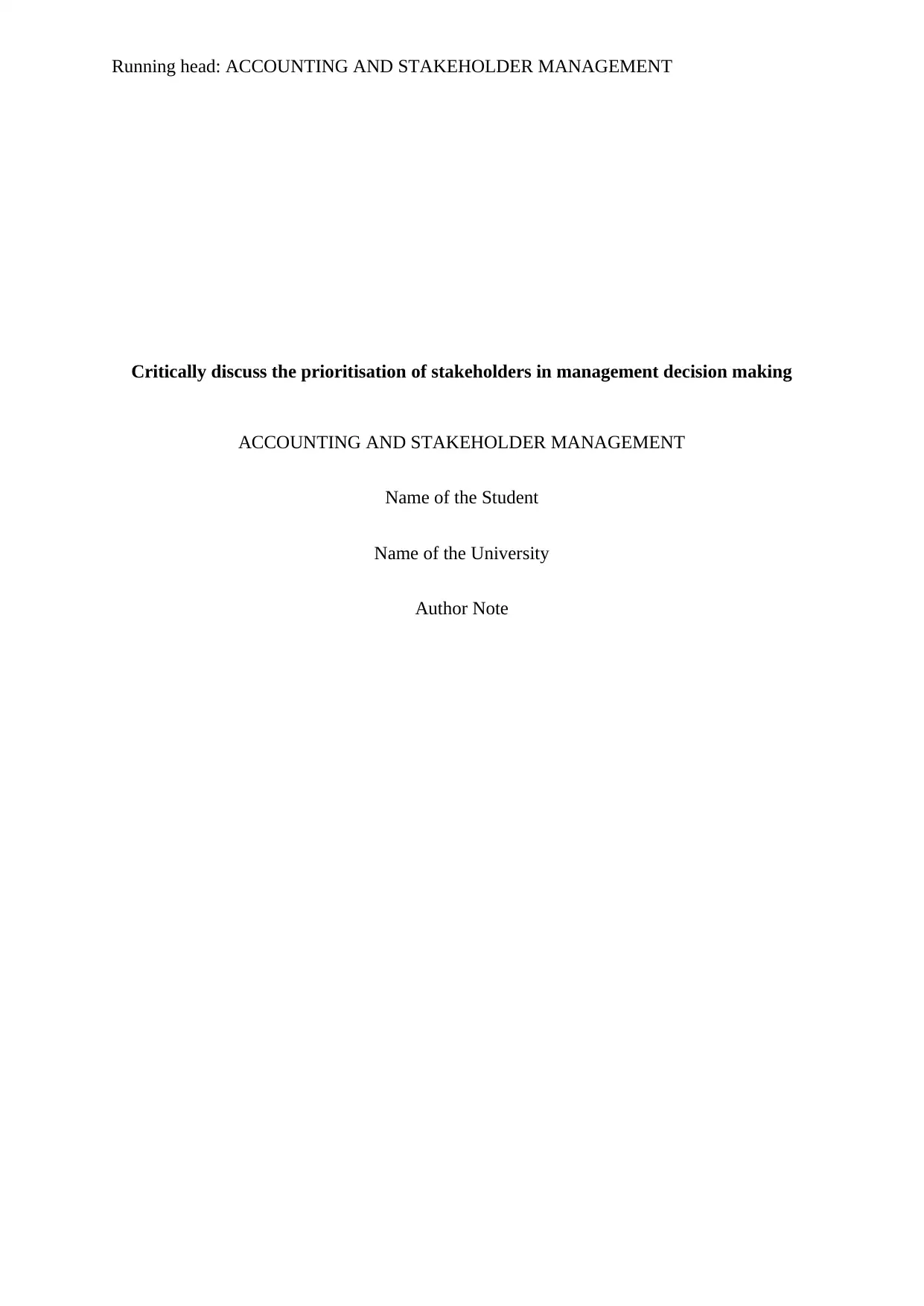
Running head: ACCOUNTING AND STAKEHOLDER MANAGEMENT
Critically discuss the prioritisation of stakeholders in management decision making
ACCOUNTING AND STAKEHOLDER MANAGEMENT
Name of the Student
Name of the University
Author Note
Critically discuss the prioritisation of stakeholders in management decision making
ACCOUNTING AND STAKEHOLDER MANAGEMENT
Name of the Student
Name of the University
Author Note
Paraphrase This Document
Need a fresh take? Get an instant paraphrase of this document with our AI Paraphraser
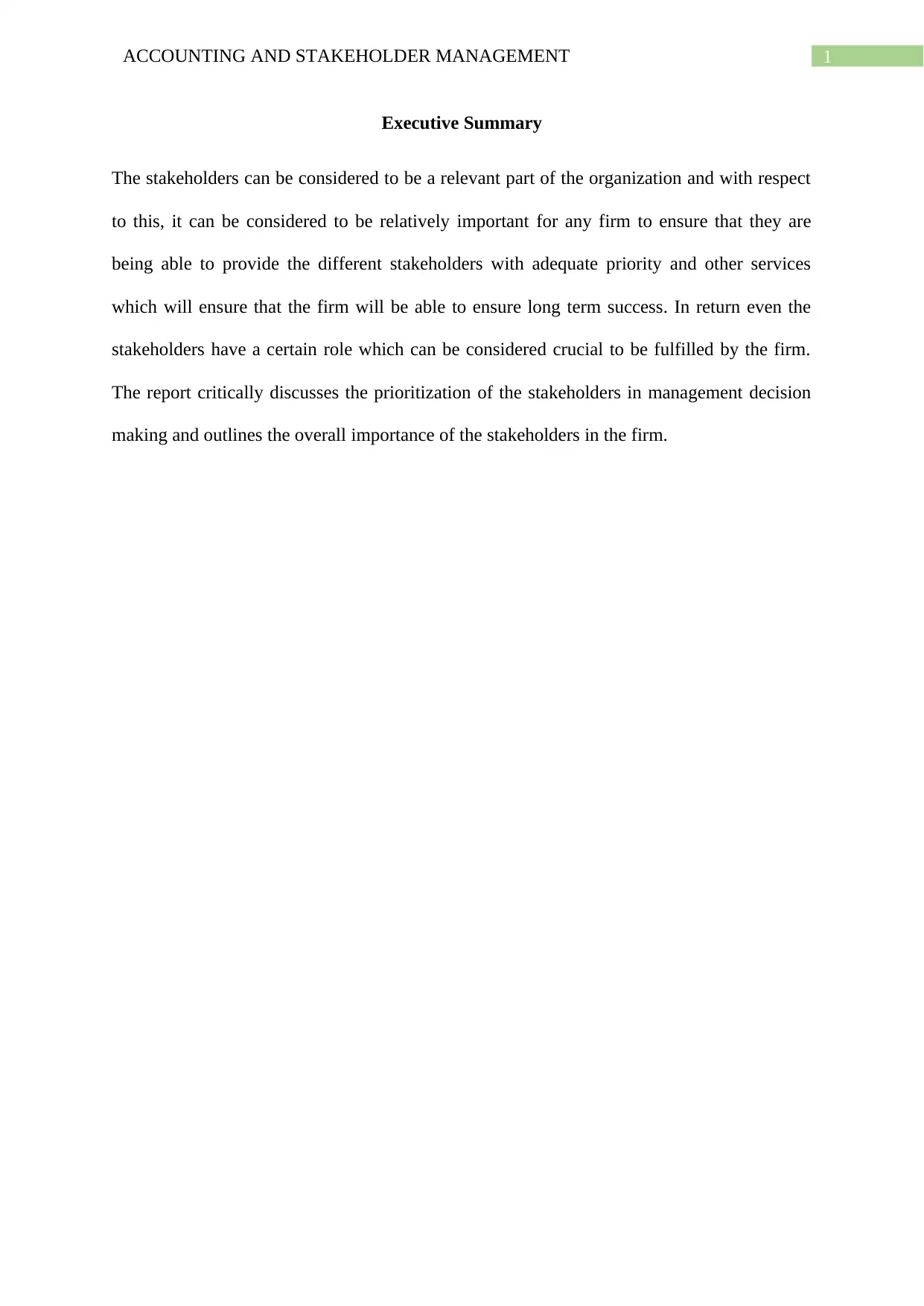
1ACCOUNTING AND STAKEHOLDER MANAGEMENT
Executive Summary
The stakeholders can be considered to be a relevant part of the organization and with respect
to this, it can be considered to be relatively important for any firm to ensure that they are
being able to provide the different stakeholders with adequate priority and other services
which will ensure that the firm will be able to ensure long term success. In return even the
stakeholders have a certain role which can be considered crucial to be fulfilled by the firm.
The report critically discusses the prioritization of the stakeholders in management decision
making and outlines the overall importance of the stakeholders in the firm.
Executive Summary
The stakeholders can be considered to be a relevant part of the organization and with respect
to this, it can be considered to be relatively important for any firm to ensure that they are
being able to provide the different stakeholders with adequate priority and other services
which will ensure that the firm will be able to ensure long term success. In return even the
stakeholders have a certain role which can be considered crucial to be fulfilled by the firm.
The report critically discusses the prioritization of the stakeholders in management decision
making and outlines the overall importance of the stakeholders in the firm.
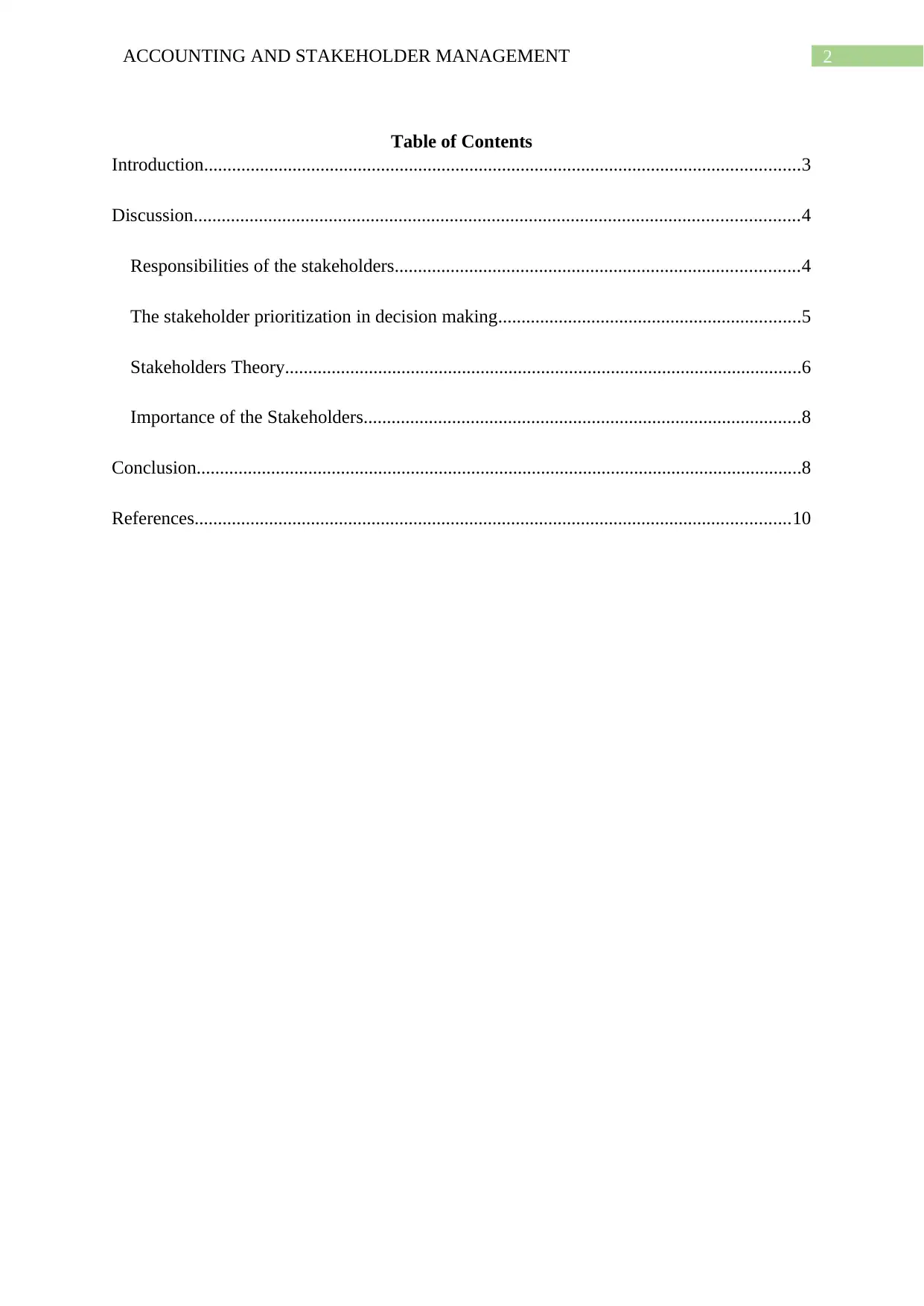
2ACCOUNTING AND STAKEHOLDER MANAGEMENT
Table of Contents
Introduction................................................................................................................................3
Discussion..................................................................................................................................4
Responsibilities of the stakeholders.......................................................................................4
The stakeholder prioritization in decision making.................................................................5
Stakeholders Theory...............................................................................................................6
Importance of the Stakeholders..............................................................................................8
Conclusion..................................................................................................................................8
References................................................................................................................................10
Table of Contents
Introduction................................................................................................................................3
Discussion..................................................................................................................................4
Responsibilities of the stakeholders.......................................................................................4
The stakeholder prioritization in decision making.................................................................5
Stakeholders Theory...............................................................................................................6
Importance of the Stakeholders..............................................................................................8
Conclusion..................................................................................................................................8
References................................................................................................................................10
⊘ This is a preview!⊘
Do you want full access?
Subscribe today to unlock all pages.

Trusted by 1+ million students worldwide
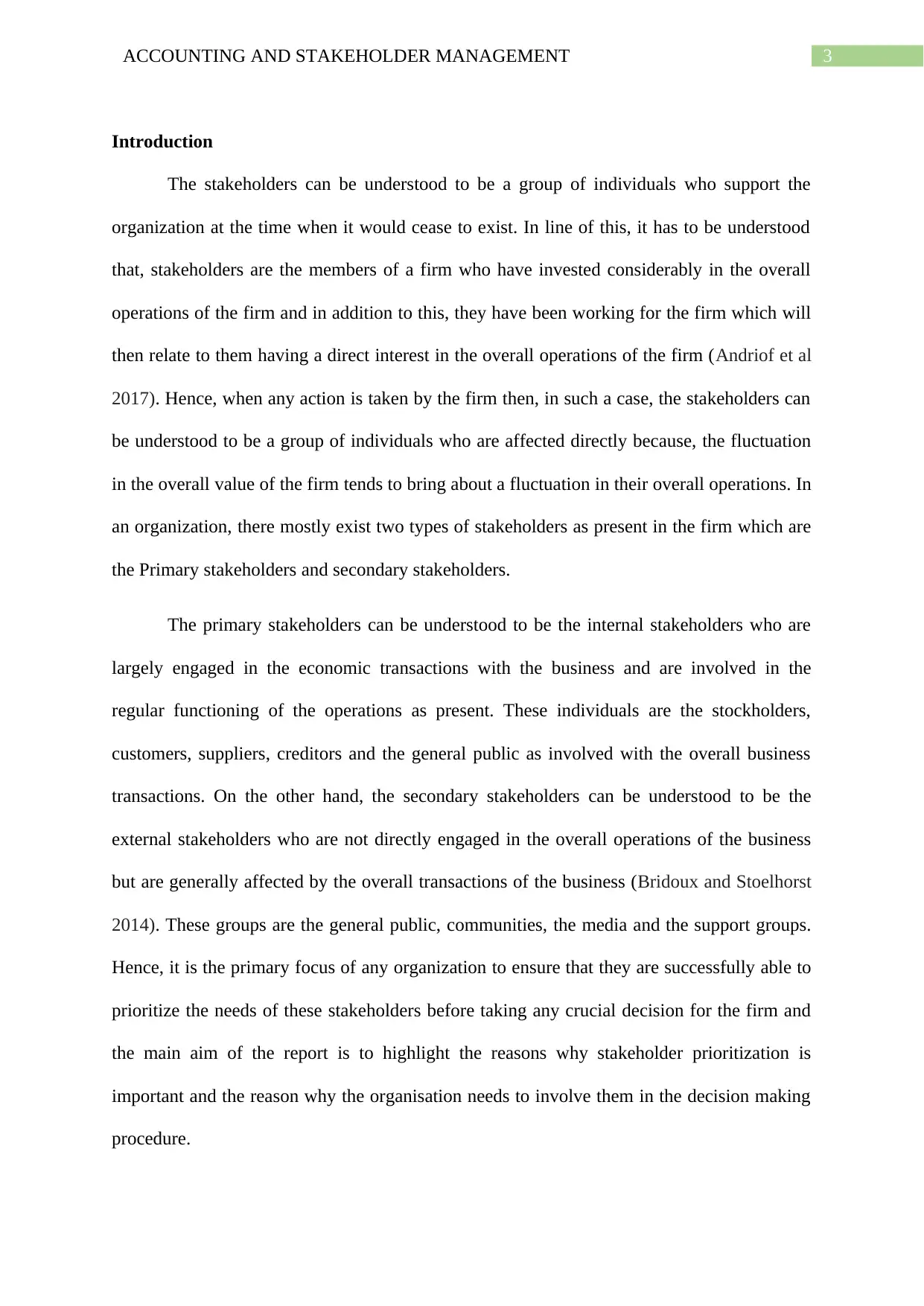
3ACCOUNTING AND STAKEHOLDER MANAGEMENT
Introduction
The stakeholders can be understood to be a group of individuals who support the
organization at the time when it would cease to exist. In line of this, it has to be understood
that, stakeholders are the members of a firm who have invested considerably in the overall
operations of the firm and in addition to this, they have been working for the firm which will
then relate to them having a direct interest in the overall operations of the firm (Andriof et al
2017). Hence, when any action is taken by the firm then, in such a case, the stakeholders can
be understood to be a group of individuals who are affected directly because, the fluctuation
in the overall value of the firm tends to bring about a fluctuation in their overall operations. In
an organization, there mostly exist two types of stakeholders as present in the firm which are
the Primary stakeholders and secondary stakeholders.
The primary stakeholders can be understood to be the internal stakeholders who are
largely engaged in the economic transactions with the business and are involved in the
regular functioning of the operations as present. These individuals are the stockholders,
customers, suppliers, creditors and the general public as involved with the overall business
transactions. On the other hand, the secondary stakeholders can be understood to be the
external stakeholders who are not directly engaged in the overall operations of the business
but are generally affected by the overall transactions of the business (Bridoux and Stoelhorst
2014). These groups are the general public, communities, the media and the support groups.
Hence, it is the primary focus of any organization to ensure that they are successfully able to
prioritize the needs of these stakeholders before taking any crucial decision for the firm and
the main aim of the report is to highlight the reasons why stakeholder prioritization is
important and the reason why the organisation needs to involve them in the decision making
procedure.
Introduction
The stakeholders can be understood to be a group of individuals who support the
organization at the time when it would cease to exist. In line of this, it has to be understood
that, stakeholders are the members of a firm who have invested considerably in the overall
operations of the firm and in addition to this, they have been working for the firm which will
then relate to them having a direct interest in the overall operations of the firm (Andriof et al
2017). Hence, when any action is taken by the firm then, in such a case, the stakeholders can
be understood to be a group of individuals who are affected directly because, the fluctuation
in the overall value of the firm tends to bring about a fluctuation in their overall operations. In
an organization, there mostly exist two types of stakeholders as present in the firm which are
the Primary stakeholders and secondary stakeholders.
The primary stakeholders can be understood to be the internal stakeholders who are
largely engaged in the economic transactions with the business and are involved in the
regular functioning of the operations as present. These individuals are the stockholders,
customers, suppliers, creditors and the general public as involved with the overall business
transactions. On the other hand, the secondary stakeholders can be understood to be the
external stakeholders who are not directly engaged in the overall operations of the business
but are generally affected by the overall transactions of the business (Bridoux and Stoelhorst
2014). These groups are the general public, communities, the media and the support groups.
Hence, it is the primary focus of any organization to ensure that they are successfully able to
prioritize the needs of these stakeholders before taking any crucial decision for the firm and
the main aim of the report is to highlight the reasons why stakeholder prioritization is
important and the reason why the organisation needs to involve them in the decision making
procedure.
Paraphrase This Document
Need a fresh take? Get an instant paraphrase of this document with our AI Paraphraser
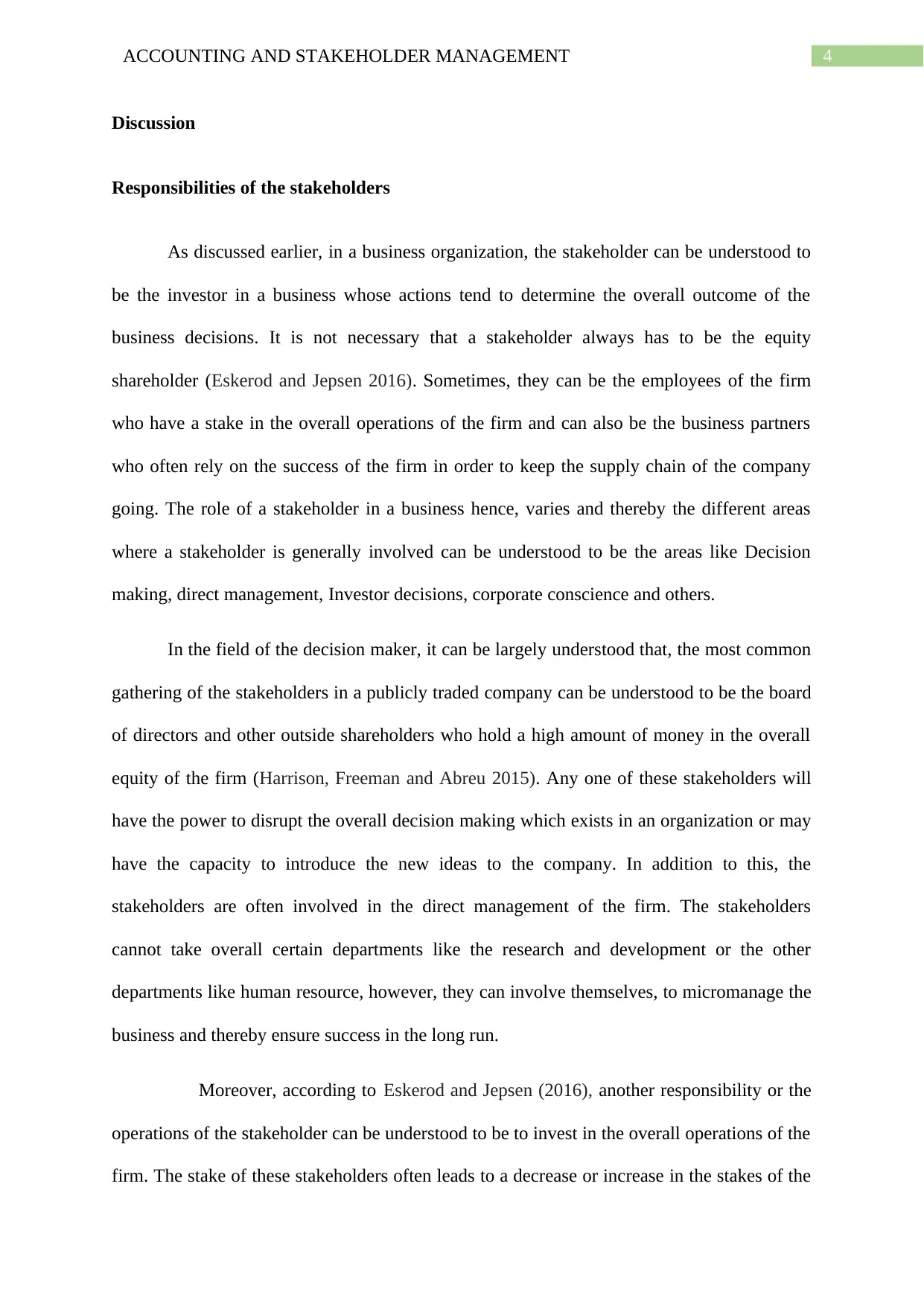
4ACCOUNTING AND STAKEHOLDER MANAGEMENT
Discussion
Responsibilities of the stakeholders
As discussed earlier, in a business organization, the stakeholder can be understood to
be the investor in a business whose actions tend to determine the overall outcome of the
business decisions. It is not necessary that a stakeholder always has to be the equity
shareholder (Eskerod and Jepsen 2016). Sometimes, they can be the employees of the firm
who have a stake in the overall operations of the firm and can also be the business partners
who often rely on the success of the firm in order to keep the supply chain of the company
going. The role of a stakeholder in a business hence, varies and thereby the different areas
where a stakeholder is generally involved can be understood to be the areas like Decision
making, direct management, Investor decisions, corporate conscience and others.
In the field of the decision maker, it can be largely understood that, the most common
gathering of the stakeholders in a publicly traded company can be understood to be the board
of directors and other outside shareholders who hold a high amount of money in the overall
equity of the firm (Harrison, Freeman and Abreu 2015). Any one of these stakeholders will
have the power to disrupt the overall decision making which exists in an organization or may
have the capacity to introduce the new ideas to the company. In addition to this, the
stakeholders are often involved in the direct management of the firm. The stakeholders
cannot take overall certain departments like the research and development or the other
departments like human resource, however, they can involve themselves, to micromanage the
business and thereby ensure success in the long run.
Moreover, according to Eskerod and Jepsen (2016), another responsibility or the
operations of the stakeholder can be understood to be to invest in the overall operations of the
firm. The stake of these stakeholders often leads to a decrease or increase in the stakes of the
Discussion
Responsibilities of the stakeholders
As discussed earlier, in a business organization, the stakeholder can be understood to
be the investor in a business whose actions tend to determine the overall outcome of the
business decisions. It is not necessary that a stakeholder always has to be the equity
shareholder (Eskerod and Jepsen 2016). Sometimes, they can be the employees of the firm
who have a stake in the overall operations of the firm and can also be the business partners
who often rely on the success of the firm in order to keep the supply chain of the company
going. The role of a stakeholder in a business hence, varies and thereby the different areas
where a stakeholder is generally involved can be understood to be the areas like Decision
making, direct management, Investor decisions, corporate conscience and others.
In the field of the decision maker, it can be largely understood that, the most common
gathering of the stakeholders in a publicly traded company can be understood to be the board
of directors and other outside shareholders who hold a high amount of money in the overall
equity of the firm (Harrison, Freeman and Abreu 2015). Any one of these stakeholders will
have the power to disrupt the overall decision making which exists in an organization or may
have the capacity to introduce the new ideas to the company. In addition to this, the
stakeholders are often involved in the direct management of the firm. The stakeholders
cannot take overall certain departments like the research and development or the other
departments like human resource, however, they can involve themselves, to micromanage the
business and thereby ensure success in the long run.
Moreover, according to Eskerod and Jepsen (2016), another responsibility or the
operations of the stakeholder can be understood to be to invest in the overall operations of the
firm. The stake of these stakeholders often leads to a decrease or increase in the stakes of the
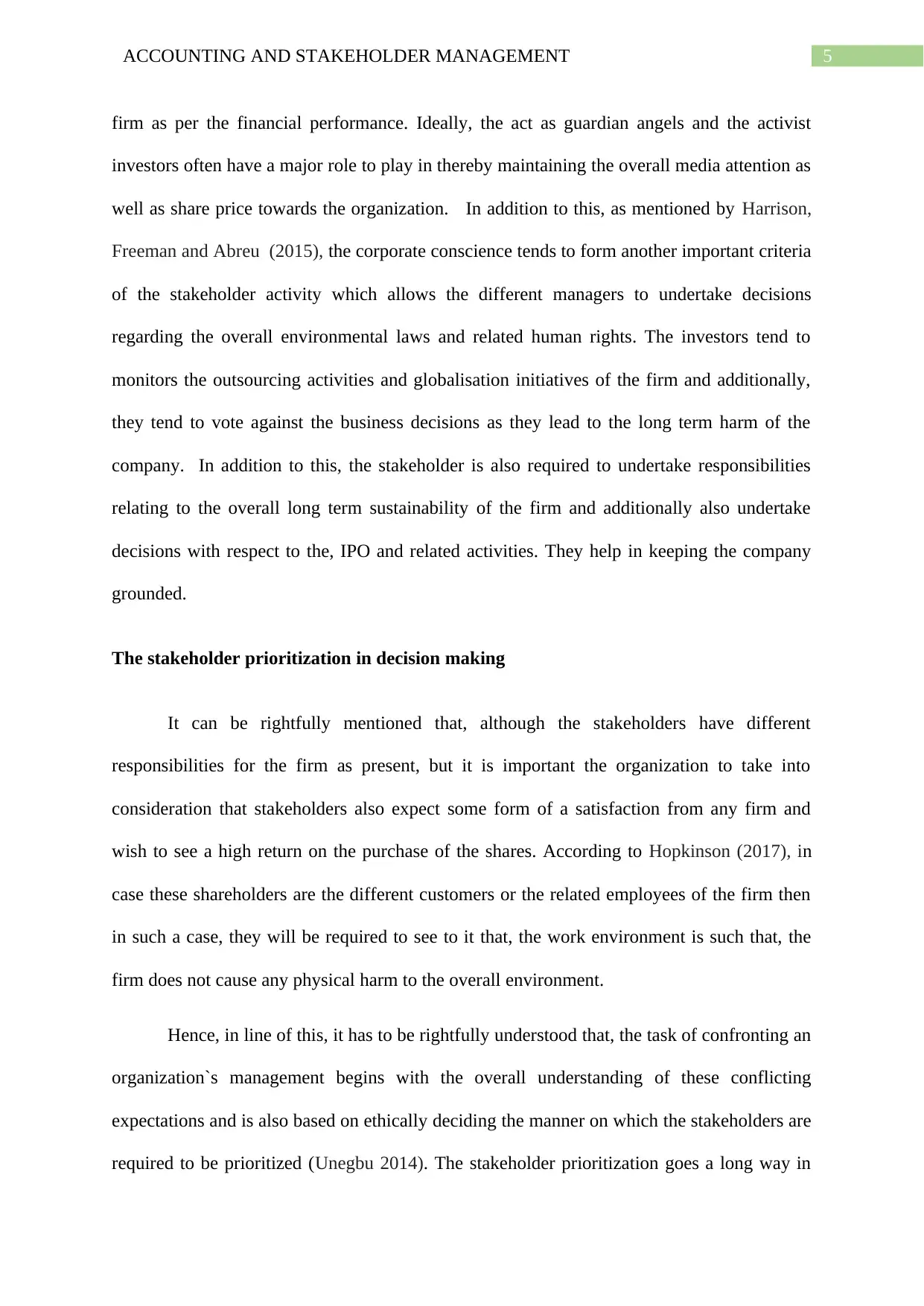
5ACCOUNTING AND STAKEHOLDER MANAGEMENT
firm as per the financial performance. Ideally, the act as guardian angels and the activist
investors often have a major role to play in thereby maintaining the overall media attention as
well as share price towards the organization. In addition to this, as mentioned by Harrison,
Freeman and Abreu (2015), the corporate conscience tends to form another important criteria
of the stakeholder activity which allows the different managers to undertake decisions
regarding the overall environmental laws and related human rights. The investors tend to
monitors the outsourcing activities and globalisation initiatives of the firm and additionally,
they tend to vote against the business decisions as they lead to the long term harm of the
company. In addition to this, the stakeholder is also required to undertake responsibilities
relating to the overall long term sustainability of the firm and additionally also undertake
decisions with respect to the, IPO and related activities. They help in keeping the company
grounded.
The stakeholder prioritization in decision making
It can be rightfully mentioned that, although the stakeholders have different
responsibilities for the firm as present, but it is important the organization to take into
consideration that stakeholders also expect some form of a satisfaction from any firm and
wish to see a high return on the purchase of the shares. According to Hopkinson (2017), in
case these shareholders are the different customers or the related employees of the firm then
in such a case, they will be required to see to it that, the work environment is such that, the
firm does not cause any physical harm to the overall environment.
Hence, in line of this, it has to be rightfully understood that, the task of confronting an
organization`s management begins with the overall understanding of these conflicting
expectations and is also based on ethically deciding the manner on which the stakeholders are
required to be prioritized (Unegbu 2014). The stakeholder prioritization goes a long way in
firm as per the financial performance. Ideally, the act as guardian angels and the activist
investors often have a major role to play in thereby maintaining the overall media attention as
well as share price towards the organization. In addition to this, as mentioned by Harrison,
Freeman and Abreu (2015), the corporate conscience tends to form another important criteria
of the stakeholder activity which allows the different managers to undertake decisions
regarding the overall environmental laws and related human rights. The investors tend to
monitors the outsourcing activities and globalisation initiatives of the firm and additionally,
they tend to vote against the business decisions as they lead to the long term harm of the
company. In addition to this, the stakeholder is also required to undertake responsibilities
relating to the overall long term sustainability of the firm and additionally also undertake
decisions with respect to the, IPO and related activities. They help in keeping the company
grounded.
The stakeholder prioritization in decision making
It can be rightfully mentioned that, although the stakeholders have different
responsibilities for the firm as present, but it is important the organization to take into
consideration that stakeholders also expect some form of a satisfaction from any firm and
wish to see a high return on the purchase of the shares. According to Hopkinson (2017), in
case these shareholders are the different customers or the related employees of the firm then
in such a case, they will be required to see to it that, the work environment is such that, the
firm does not cause any physical harm to the overall environment.
Hence, in line of this, it has to be rightfully understood that, the task of confronting an
organization`s management begins with the overall understanding of these conflicting
expectations and is also based on ethically deciding the manner on which the stakeholders are
required to be prioritized (Unegbu 2014). The stakeholder prioritization goes a long way in
⊘ This is a preview!⊘
Do you want full access?
Subscribe today to unlock all pages.

Trusted by 1+ million students worldwide
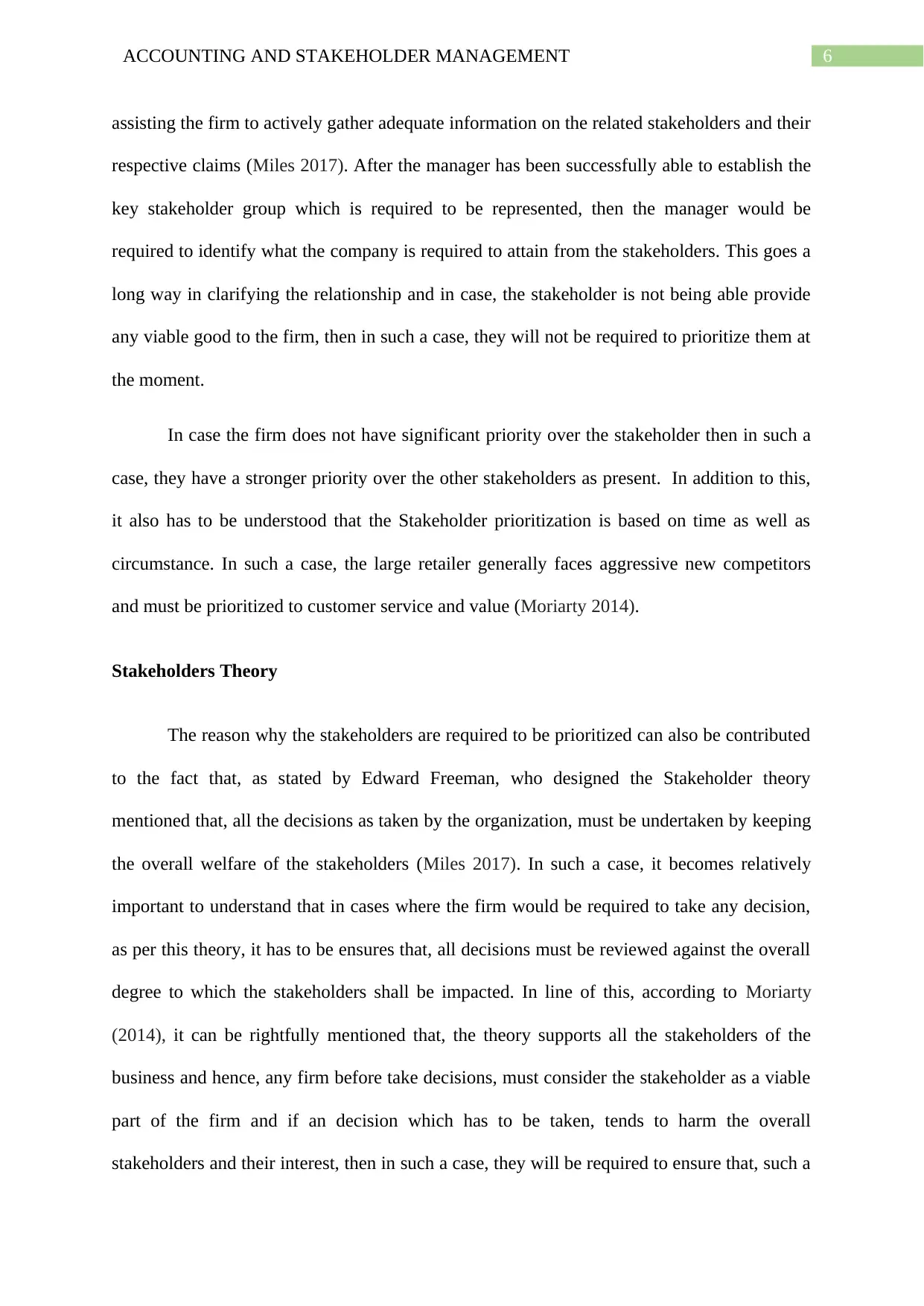
6ACCOUNTING AND STAKEHOLDER MANAGEMENT
assisting the firm to actively gather adequate information on the related stakeholders and their
respective claims (Miles 2017). After the manager has been successfully able to establish the
key stakeholder group which is required to be represented, then the manager would be
required to identify what the company is required to attain from the stakeholders. This goes a
long way in clarifying the relationship and in case, the stakeholder is not being able provide
any viable good to the firm, then in such a case, they will not be required to prioritize them at
the moment.
In case the firm does not have significant priority over the stakeholder then in such a
case, they have a stronger priority over the other stakeholders as present. In addition to this,
it also has to be understood that the Stakeholder prioritization is based on time as well as
circumstance. In such a case, the large retailer generally faces aggressive new competitors
and must be prioritized to customer service and value (Moriarty 2014).
Stakeholders Theory
The reason why the stakeholders are required to be prioritized can also be contributed
to the fact that, as stated by Edward Freeman, who designed the Stakeholder theory
mentioned that, all the decisions as taken by the organization, must be undertaken by keeping
the overall welfare of the stakeholders (Miles 2017). In such a case, it becomes relatively
important to understand that in cases where the firm would be required to take any decision,
as per this theory, it has to be ensures that, all decisions must be reviewed against the overall
degree to which the stakeholders shall be impacted. In line of this, according to Moriarty
(2014), it can be rightfully mentioned that, the theory supports all the stakeholders of the
business and hence, any firm before take decisions, must consider the stakeholder as a viable
part of the firm and if an decision which has to be taken, tends to harm the overall
stakeholders and their interest, then in such a case, they will be required to ensure that, such a
assisting the firm to actively gather adequate information on the related stakeholders and their
respective claims (Miles 2017). After the manager has been successfully able to establish the
key stakeholder group which is required to be represented, then the manager would be
required to identify what the company is required to attain from the stakeholders. This goes a
long way in clarifying the relationship and in case, the stakeholder is not being able provide
any viable good to the firm, then in such a case, they will not be required to prioritize them at
the moment.
In case the firm does not have significant priority over the stakeholder then in such a
case, they have a stronger priority over the other stakeholders as present. In addition to this,
it also has to be understood that the Stakeholder prioritization is based on time as well as
circumstance. In such a case, the large retailer generally faces aggressive new competitors
and must be prioritized to customer service and value (Moriarty 2014).
Stakeholders Theory
The reason why the stakeholders are required to be prioritized can also be contributed
to the fact that, as stated by Edward Freeman, who designed the Stakeholder theory
mentioned that, all the decisions as taken by the organization, must be undertaken by keeping
the overall welfare of the stakeholders (Miles 2017). In such a case, it becomes relatively
important to understand that in cases where the firm would be required to take any decision,
as per this theory, it has to be ensures that, all decisions must be reviewed against the overall
degree to which the stakeholders shall be impacted. In line of this, according to Moriarty
(2014), it can be rightfully mentioned that, the theory supports all the stakeholders of the
business and hence, any firm before take decisions, must consider the stakeholder as a viable
part of the firm and if an decision which has to be taken, tends to harm the overall
stakeholders and their interest, then in such a case, they will be required to ensure that, such a
Paraphrase This Document
Need a fresh take? Get an instant paraphrase of this document with our AI Paraphraser
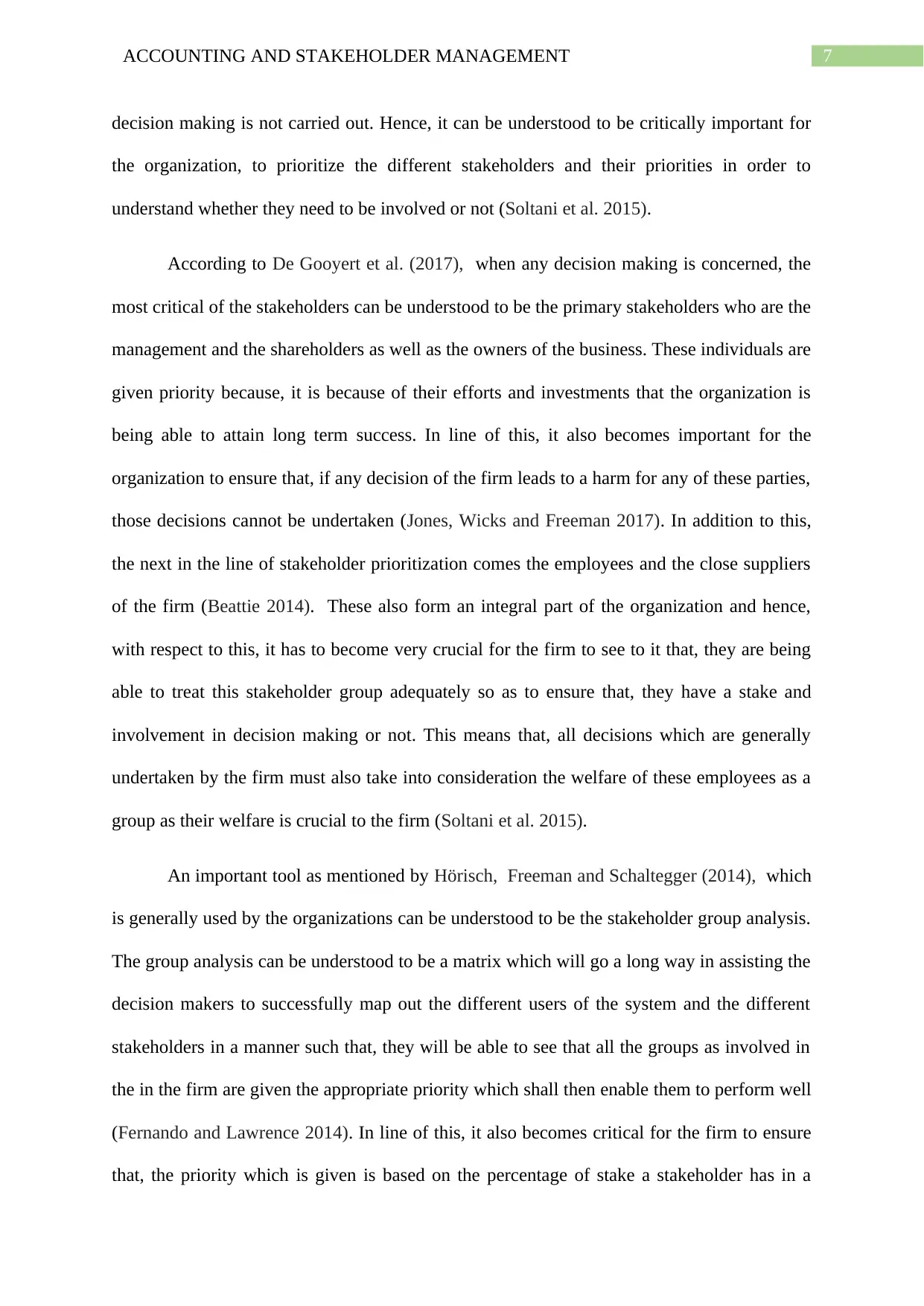
7ACCOUNTING AND STAKEHOLDER MANAGEMENT
decision making is not carried out. Hence, it can be understood to be critically important for
the organization, to prioritize the different stakeholders and their priorities in order to
understand whether they need to be involved or not (Soltani et al. 2015).
According to De Gooyert et al. (2017), when any decision making is concerned, the
most critical of the stakeholders can be understood to be the primary stakeholders who are the
management and the shareholders as well as the owners of the business. These individuals are
given priority because, it is because of their efforts and investments that the organization is
being able to attain long term success. In line of this, it also becomes important for the
organization to ensure that, if any decision of the firm leads to a harm for any of these parties,
those decisions cannot be undertaken (Jones, Wicks and Freeman 2017). In addition to this,
the next in the line of stakeholder prioritization comes the employees and the close suppliers
of the firm (Beattie 2014). These also form an integral part of the organization and hence,
with respect to this, it has to become very crucial for the firm to see to it that, they are being
able to treat this stakeholder group adequately so as to ensure that, they have a stake and
involvement in decision making or not. This means that, all decisions which are generally
undertaken by the firm must also take into consideration the welfare of these employees as a
group as their welfare is crucial to the firm (Soltani et al. 2015).
An important tool as mentioned by Hörisch, Freeman and Schaltegger (2014), which
is generally used by the organizations can be understood to be the stakeholder group analysis.
The group analysis can be understood to be a matrix which will go a long way in assisting the
decision makers to successfully map out the different users of the system and the different
stakeholders in a manner such that, they will be able to see that all the groups as involved in
the in the firm are given the appropriate priority which shall then enable them to perform well
(Fernando and Lawrence 2014). In line of this, it also becomes critical for the firm to ensure
that, the priority which is given is based on the percentage of stake a stakeholder has in a
decision making is not carried out. Hence, it can be understood to be critically important for
the organization, to prioritize the different stakeholders and their priorities in order to
understand whether they need to be involved or not (Soltani et al. 2015).
According to De Gooyert et al. (2017), when any decision making is concerned, the
most critical of the stakeholders can be understood to be the primary stakeholders who are the
management and the shareholders as well as the owners of the business. These individuals are
given priority because, it is because of their efforts and investments that the organization is
being able to attain long term success. In line of this, it also becomes important for the
organization to ensure that, if any decision of the firm leads to a harm for any of these parties,
those decisions cannot be undertaken (Jones, Wicks and Freeman 2017). In addition to this,
the next in the line of stakeholder prioritization comes the employees and the close suppliers
of the firm (Beattie 2014). These also form an integral part of the organization and hence,
with respect to this, it has to become very crucial for the firm to see to it that, they are being
able to treat this stakeholder group adequately so as to ensure that, they have a stake and
involvement in decision making or not. This means that, all decisions which are generally
undertaken by the firm must also take into consideration the welfare of these employees as a
group as their welfare is crucial to the firm (Soltani et al. 2015).
An important tool as mentioned by Hörisch, Freeman and Schaltegger (2014), which
is generally used by the organizations can be understood to be the stakeholder group analysis.
The group analysis can be understood to be a matrix which will go a long way in assisting the
decision makers to successfully map out the different users of the system and the different
stakeholders in a manner such that, they will be able to see that all the groups as involved in
the in the firm are given the appropriate priority which shall then enable them to perform well
(Fernando and Lawrence 2014). In line of this, it also becomes critical for the firm to ensure
that, the priority which is given is based on the percentage of stake a stakeholder has in a
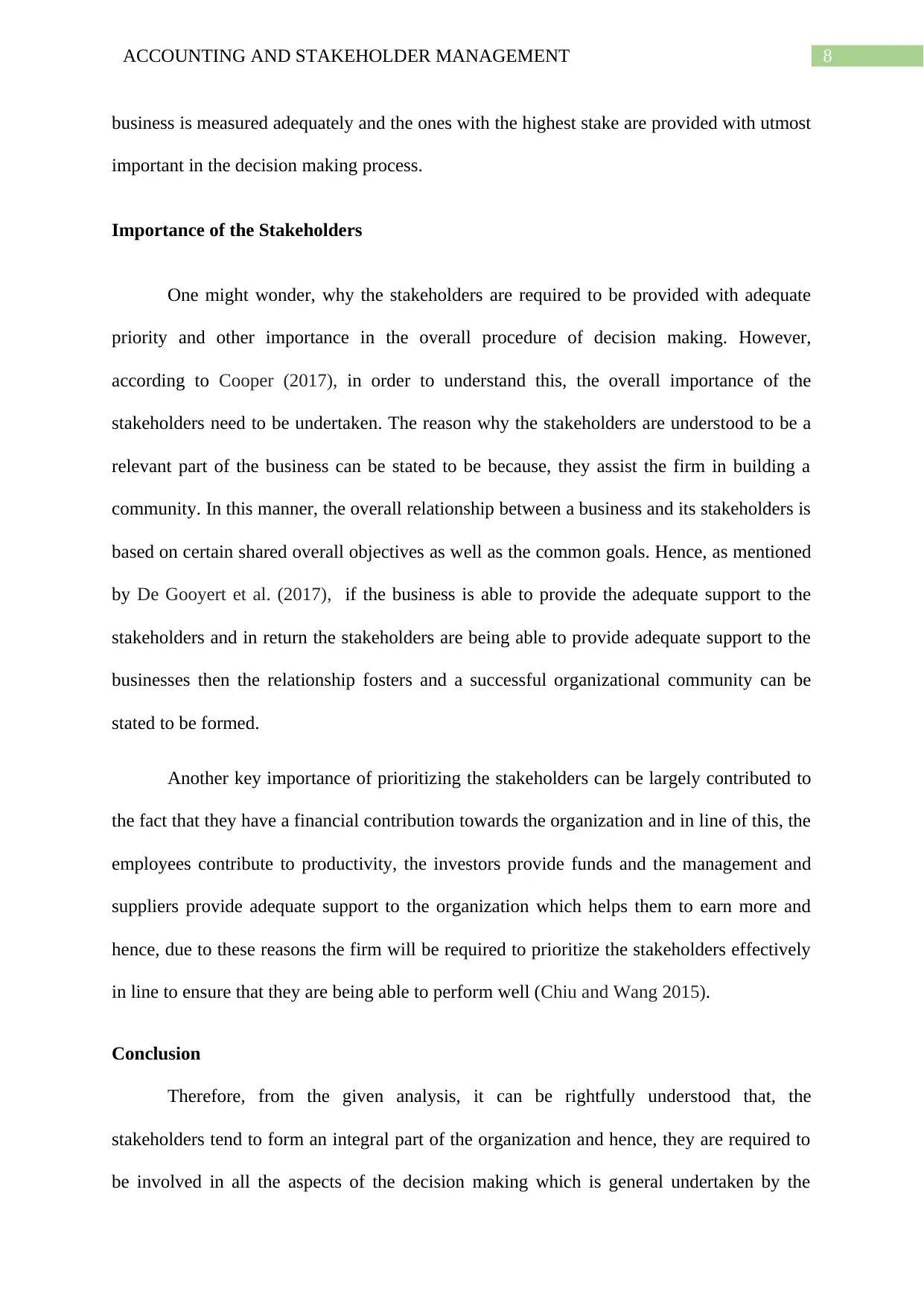
8ACCOUNTING AND STAKEHOLDER MANAGEMENT
business is measured adequately and the ones with the highest stake are provided with utmost
important in the decision making process.
Importance of the Stakeholders
One might wonder, why the stakeholders are required to be provided with adequate
priority and other importance in the overall procedure of decision making. However,
according to Cooper (2017), in order to understand this, the overall importance of the
stakeholders need to be undertaken. The reason why the stakeholders are understood to be a
relevant part of the business can be stated to be because, they assist the firm in building a
community. In this manner, the overall relationship between a business and its stakeholders is
based on certain shared overall objectives as well as the common goals. Hence, as mentioned
by De Gooyert et al. (2017), if the business is able to provide the adequate support to the
stakeholders and in return the stakeholders are being able to provide adequate support to the
businesses then the relationship fosters and a successful organizational community can be
stated to be formed.
Another key importance of prioritizing the stakeholders can be largely contributed to
the fact that they have a financial contribution towards the organization and in line of this, the
employees contribute to productivity, the investors provide funds and the management and
suppliers provide adequate support to the organization which helps them to earn more and
hence, due to these reasons the firm will be required to prioritize the stakeholders effectively
in line to ensure that they are being able to perform well (Chiu and Wang 2015).
Conclusion
Therefore, from the given analysis, it can be rightfully understood that, the
stakeholders tend to form an integral part of the organization and hence, they are required to
be involved in all the aspects of the decision making which is general undertaken by the
business is measured adequately and the ones with the highest stake are provided with utmost
important in the decision making process.
Importance of the Stakeholders
One might wonder, why the stakeholders are required to be provided with adequate
priority and other importance in the overall procedure of decision making. However,
according to Cooper (2017), in order to understand this, the overall importance of the
stakeholders need to be undertaken. The reason why the stakeholders are understood to be a
relevant part of the business can be stated to be because, they assist the firm in building a
community. In this manner, the overall relationship between a business and its stakeholders is
based on certain shared overall objectives as well as the common goals. Hence, as mentioned
by De Gooyert et al. (2017), if the business is able to provide the adequate support to the
stakeholders and in return the stakeholders are being able to provide adequate support to the
businesses then the relationship fosters and a successful organizational community can be
stated to be formed.
Another key importance of prioritizing the stakeholders can be largely contributed to
the fact that they have a financial contribution towards the organization and in line of this, the
employees contribute to productivity, the investors provide funds and the management and
suppliers provide adequate support to the organization which helps them to earn more and
hence, due to these reasons the firm will be required to prioritize the stakeholders effectively
in line to ensure that they are being able to perform well (Chiu and Wang 2015).
Conclusion
Therefore, from the given analysis, it can be rightfully understood that, the
stakeholders tend to form an integral part of the organization and hence, they are required to
be involved in all the aspects of the decision making which is general undertaken by the
⊘ This is a preview!⊘
Do you want full access?
Subscribe today to unlock all pages.

Trusted by 1+ million students worldwide

9ACCOUNTING AND STAKEHOLDER MANAGEMENT
organization. The given report analysed the overall reason why the stakeholders are
understood to be an integral part of the firm and in line of this, the reason why stakeholder
prioritization is crucial in the decision making has also been critically discussed an analysed.
organization. The given report analysed the overall reason why the stakeholders are
understood to be an integral part of the firm and in line of this, the reason why stakeholder
prioritization is crucial in the decision making has also been critically discussed an analysed.
Paraphrase This Document
Need a fresh take? Get an instant paraphrase of this document with our AI Paraphraser
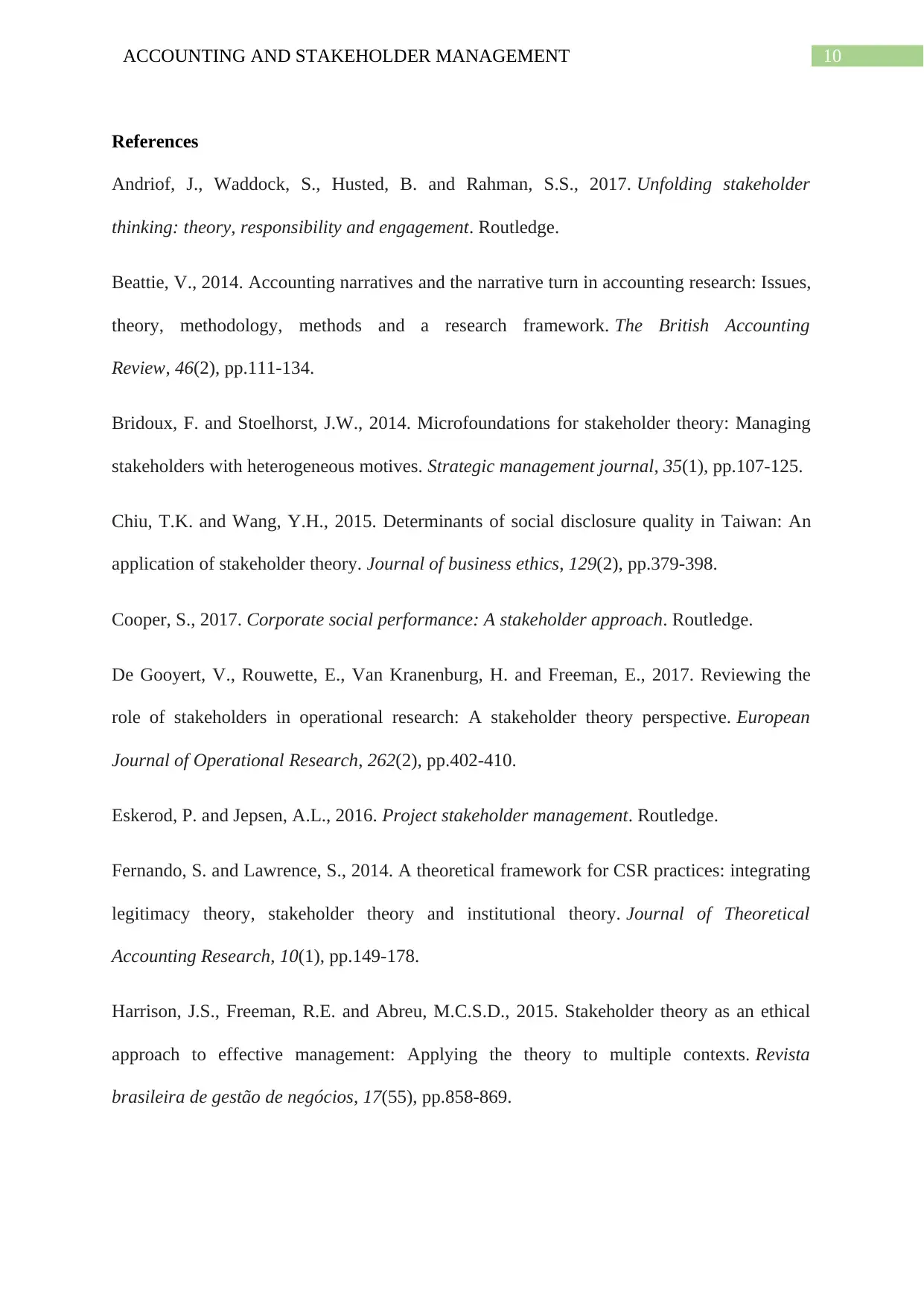
10ACCOUNTING AND STAKEHOLDER MANAGEMENT
References
Andriof, J., Waddock, S., Husted, B. and Rahman, S.S., 2017. Unfolding stakeholder
thinking: theory, responsibility and engagement. Routledge.
Beattie, V., 2014. Accounting narratives and the narrative turn in accounting research: Issues,
theory, methodology, methods and a research framework. The British Accounting
Review, 46(2), pp.111-134.
Bridoux, F. and Stoelhorst, J.W., 2014. Microfoundations for stakeholder theory: Managing
stakeholders with heterogeneous motives. Strategic management journal, 35(1), pp.107-125.
Chiu, T.K. and Wang, Y.H., 2015. Determinants of social disclosure quality in Taiwan: An
application of stakeholder theory. Journal of business ethics, 129(2), pp.379-398.
Cooper, S., 2017. Corporate social performance: A stakeholder approach. Routledge.
De Gooyert, V., Rouwette, E., Van Kranenburg, H. and Freeman, E., 2017. Reviewing the
role of stakeholders in operational research: A stakeholder theory perspective. European
Journal of Operational Research, 262(2), pp.402-410.
Eskerod, P. and Jepsen, A.L., 2016. Project stakeholder management. Routledge.
Fernando, S. and Lawrence, S., 2014. A theoretical framework for CSR practices: integrating
legitimacy theory, stakeholder theory and institutional theory. Journal of Theoretical
Accounting Research, 10(1), pp.149-178.
Harrison, J.S., Freeman, R.E. and Abreu, M.C.S.D., 2015. Stakeholder theory as an ethical
approach to effective management: Applying the theory to multiple contexts. Revista
brasileira de gestão de negócios, 17(55), pp.858-869.
References
Andriof, J., Waddock, S., Husted, B. and Rahman, S.S., 2017. Unfolding stakeholder
thinking: theory, responsibility and engagement. Routledge.
Beattie, V., 2014. Accounting narratives and the narrative turn in accounting research: Issues,
theory, methodology, methods and a research framework. The British Accounting
Review, 46(2), pp.111-134.
Bridoux, F. and Stoelhorst, J.W., 2014. Microfoundations for stakeholder theory: Managing
stakeholders with heterogeneous motives. Strategic management journal, 35(1), pp.107-125.
Chiu, T.K. and Wang, Y.H., 2015. Determinants of social disclosure quality in Taiwan: An
application of stakeholder theory. Journal of business ethics, 129(2), pp.379-398.
Cooper, S., 2017. Corporate social performance: A stakeholder approach. Routledge.
De Gooyert, V., Rouwette, E., Van Kranenburg, H. and Freeman, E., 2017. Reviewing the
role of stakeholders in operational research: A stakeholder theory perspective. European
Journal of Operational Research, 262(2), pp.402-410.
Eskerod, P. and Jepsen, A.L., 2016. Project stakeholder management. Routledge.
Fernando, S. and Lawrence, S., 2014. A theoretical framework for CSR practices: integrating
legitimacy theory, stakeholder theory and institutional theory. Journal of Theoretical
Accounting Research, 10(1), pp.149-178.
Harrison, J.S., Freeman, R.E. and Abreu, M.C.S.D., 2015. Stakeholder theory as an ethical
approach to effective management: Applying the theory to multiple contexts. Revista
brasileira de gestão de negócios, 17(55), pp.858-869.
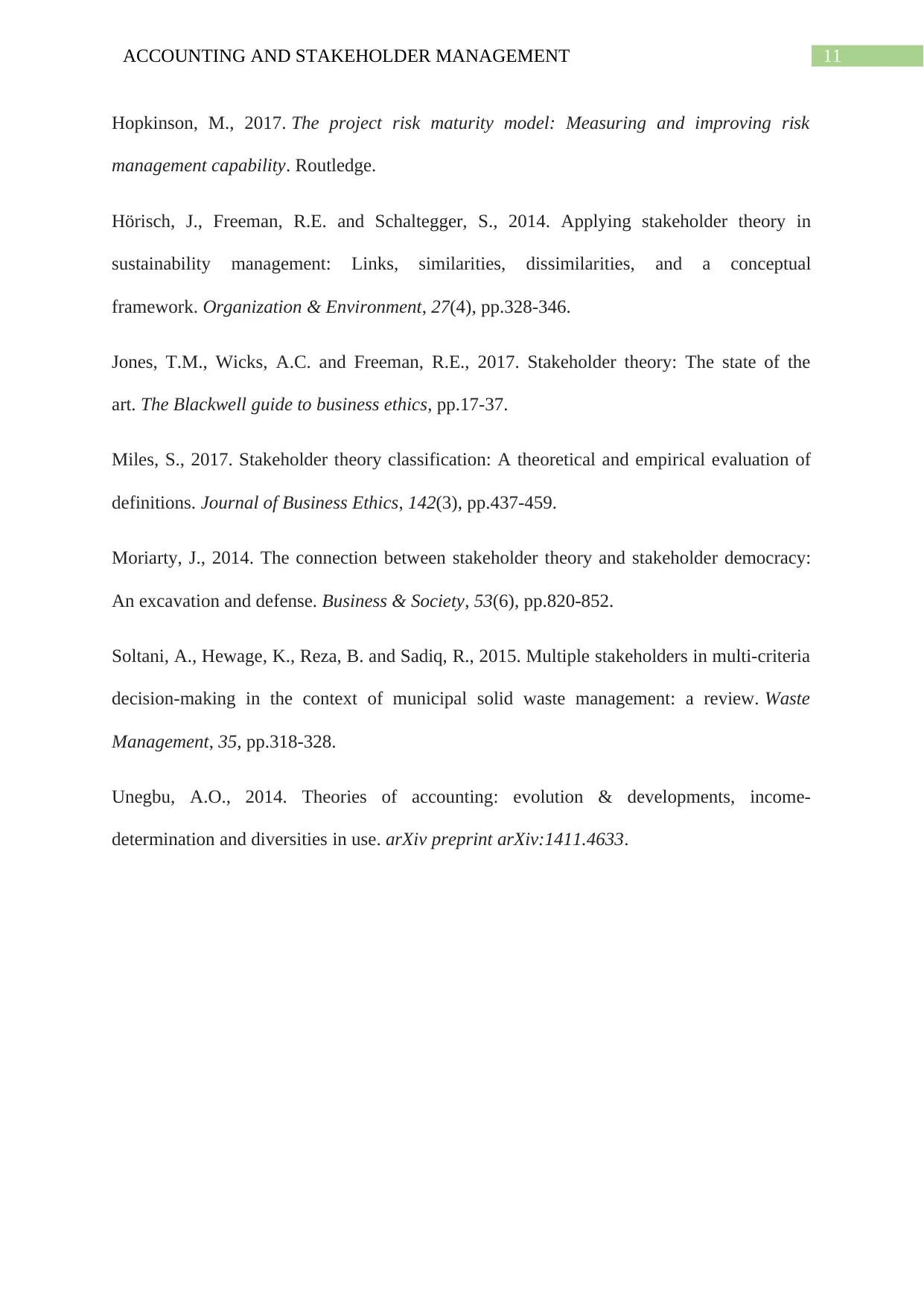
11ACCOUNTING AND STAKEHOLDER MANAGEMENT
Hopkinson, M., 2017. The project risk maturity model: Measuring and improving risk
management capability. Routledge.
Hörisch, J., Freeman, R.E. and Schaltegger, S., 2014. Applying stakeholder theory in
sustainability management: Links, similarities, dissimilarities, and a conceptual
framework. Organization & Environment, 27(4), pp.328-346.
Jones, T.M., Wicks, A.C. and Freeman, R.E., 2017. Stakeholder theory: The state of the
art. The Blackwell guide to business ethics, pp.17-37.
Miles, S., 2017. Stakeholder theory classification: A theoretical and empirical evaluation of
definitions. Journal of Business Ethics, 142(3), pp.437-459.
Moriarty, J., 2014. The connection between stakeholder theory and stakeholder democracy:
An excavation and defense. Business & Society, 53(6), pp.820-852.
Soltani, A., Hewage, K., Reza, B. and Sadiq, R., 2015. Multiple stakeholders in multi-criteria
decision-making in the context of municipal solid waste management: a review. Waste
Management, 35, pp.318-328.
Unegbu, A.O., 2014. Theories of accounting: evolution & developments, income-
determination and diversities in use. arXiv preprint arXiv:1411.4633.
Hopkinson, M., 2017. The project risk maturity model: Measuring and improving risk
management capability. Routledge.
Hörisch, J., Freeman, R.E. and Schaltegger, S., 2014. Applying stakeholder theory in
sustainability management: Links, similarities, dissimilarities, and a conceptual
framework. Organization & Environment, 27(4), pp.328-346.
Jones, T.M., Wicks, A.C. and Freeman, R.E., 2017. Stakeholder theory: The state of the
art. The Blackwell guide to business ethics, pp.17-37.
Miles, S., 2017. Stakeholder theory classification: A theoretical and empirical evaluation of
definitions. Journal of Business Ethics, 142(3), pp.437-459.
Moriarty, J., 2014. The connection between stakeholder theory and stakeholder democracy:
An excavation and defense. Business & Society, 53(6), pp.820-852.
Soltani, A., Hewage, K., Reza, B. and Sadiq, R., 2015. Multiple stakeholders in multi-criteria
decision-making in the context of municipal solid waste management: a review. Waste
Management, 35, pp.318-328.
Unegbu, A.O., 2014. Theories of accounting: evolution & developments, income-
determination and diversities in use. arXiv preprint arXiv:1411.4633.
⊘ This is a preview!⊘
Do you want full access?
Subscribe today to unlock all pages.

Trusted by 1+ million students worldwide
1 out of 12
Related Documents
Your All-in-One AI-Powered Toolkit for Academic Success.
+13062052269
info@desklib.com
Available 24*7 on WhatsApp / Email
![[object Object]](/_next/static/media/star-bottom.7253800d.svg)
Unlock your academic potential
Copyright © 2020–2025 A2Z Services. All Rights Reserved. Developed and managed by ZUCOL.





